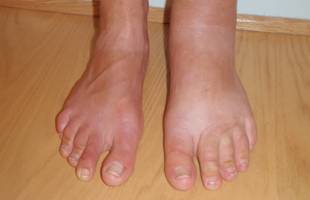Module 7: The ASEAN World of Medicine
Table of Contents
Reading Text & Presentation
7.3.5 Lymphedema

(Source: http://www.betterfunctioning.com/lymphedema.html retrieved 3/7/2014)
Caused by a blockage, or reduced circulation, in the lymphatic system, lymphedema refers to swelling that generally occurs in the arms or legs.
The lymphatic system is an important part of the immune and circulatory systems. It returns the interstitial fluid to the thoracic duct and then to the bloodstream, where it is re-circulated back to the tissues. Blockages prevent the lymph fluid from draining well. Swelling will continue as the fluid builds up. Lymphedema is often caused by damage to or removal of the lymph nodes, sometimes as a part of cancer treatment, but it is mainly inherited. It has no cure, but it can be controlled. Control involves diligent care of the affected limb.
Sometimes, lymphedema sufferers feel no discomfort or pain, but symptoms may include limbs feeling heavy or full, edema, or aching pain in the affected area. Advanced lymphedema can cause skin changes such as discoloration, verrucous (wart-like) hyperplasia, hyperkeratosis, and papillomatosis; and eventually deformity (elephantiasis).
Lymphedema is either primary (inherited) or secondary. Primary lymphedema generally occurs due to poorly developed or missing lymph nodes and/or channels in the body. It can be present at birth, develop at the onset of puberty, or become apparent in adulthood. Some cases may be associated with other vascular abnormalities. In men it generally occurs in the lower limbs with one or both legs affected.
Secondary lymphedema affects both men and women, and is often associated with the treatment of cancer conditions either by surgery or radiotherapy.
In either primary or secondary lymphedema, development is in stages from mild to severe. Systems of staging vary across the world from 3 to as many as 8 stages. A staging system described in 2007 by Lee, Morgan and Bergan identifies 4 stages, and was endorsed by the American Society of Lymphology. The system outlines clear techniques which clinical and laboratory assessment can employ. This more accurately diagnoses and prescribes therapy for the condition, as well as outlining measurable outcomes:
Stage 1: Some damage to the lymphatic vessels (not yet apparent). There is still sufficient transport capacity for lymph removal. This is described as latent lymphedema.
Stage 2: When the limb is pressed there is no ‘pitting’ and the flesh bounces back without indentation. Limbs are usually normal in size upon waking in the morning. Here the condition is spontaneously reversible.
Stage 3: There is a spongy consistency to the tissue, and when the affected area is pressed it indents and holds. This is described as ‘pitting’, and marks the beginning of limb hardening and size increase. Here the condition is spontaneously irreversible.
Stage 4: Now the swelling in the limb(s) is irreversible the affected area(s) are very large. The tissue is hard and unresponsive. Some resort to surgery at this point, but as further damage is possible it may result in the condition getting worse. This stage is termed as lymphostatic elephantiasis.
Treatments for lymphedema include; compression with special garments or pump therapy, bandaging, decongestive therapy or lymph drainage, surgery with vessel grafting or node transfer, supermicrosurgery, and liposuction. There is also laser treatment now available, but all are fraught with complications. Since it is disfiguring, lymphedema can cause difficulties in daily life, and can lead to a limited lifestyle and psychological distress.
Summary
These are just 5 common ailments, there are many more!
Sometimes people are referred to specialists when they have a particular problem that can be too complicated for a general practitioner. These specialists have special titles. Some can be found in Resource 4.
Language Focus 7.3